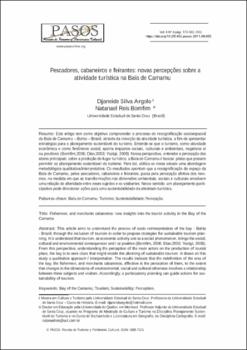Pescadores, cabaneiros e feirantes: novas percepções sobre a atividade turística na Baía de Camamu
Date
2011Abstract
Este artigo tem como objetivo compreender o processo de ressignifi cação socioespacial
da Baía de Camamu – Bahia – Brasil, através da inserção da atividade turística, a fi m de apresentar
estratégias para o planejamento sustentável do turismo. Entende-se que o turismo, como atividade
econômica e como fenômeno social, aporta impactos sociais, culturais e ambientais, negativos e/
ou positivos (Bomfi m,2006; Dias;2003; Yazigi, 2008). Nessa perspectiva, entender a percepção dos
atores principais, sobre a produção do lugar turístico, a Baía de Camamu é buscar pistas que possam
permitir ao planejamento sustentável do turismo. Para tal, utiliza-se nesse estudo uma abordagem
metodológica qualitativa/interpretativa. Os resultados apontam que a ressignifi cação do espaço da
Baía de Camamu, pelos pescadores, cabaneiros e feirantes, passa pela percepção afetiva dos mesmos,
na medida em que as transformações nas dimensões ambientais, sociais e culturais envolvem
uma relação de alteridade entre esses sujeitos e os visitantes. Nesse sentido, um planejamento participativo
pode direcionar ações para uma sustentabilidade da atividade turística. This article aims to understand the process of socio reinterpretation of the bay - Bahia
- Brazil, through the inclusion of tourism in order to propose strategies for sustainable tourism planning.
It is understood that tourism, as economic activity and as a social phenomenon, brings the social,
cultural and environmental consequences and / or positive (Bomfi m, 2006; Dias;2003; Yazigi, 2008).
From this perspective, understanding the perception of the main actors on the production of tourist
place, the bay is to seek clues that might enable the planning of sustainable tourism. It draws on this
study a qualitative approach / interpretation. The results indicate that the redefi nition of the area of
the bay, the fi shermen, and merchants cabaneiros, affective is the perception of them, to the extent
that changes in the dimensions of environmental, social and cultural otherness involves a relationship
between these subjects and visitors. Accordingly, a participatory planning can guide actions for sustainability
of tourism.





